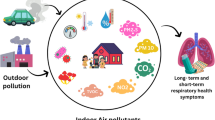Abstract
Poor ventilation at day care centres (DCCs) was already reported, although its effects on attending children are not clear. This study aimed to evaluate the association between wheezing in children and indoor CO2 (a ventilation surrogate marker) in DCC and to identify behaviours and building characteristics potentially related to CO2. In phase I, 45 DCCs from Lisbon and Oporto (Portugal) were selected through a proportional stratified random sampling. In phase II, 3 months later, 19 DCCs were further reassessed after cluster analysis for the greatest difference comparison. In both phases, children’s respiratory health was assessed by ISAAC-derived questionnaires. Indoor CO2 concentrations and building characteristics of the DCC were evaluated in both phases, using complementary methods. Mixed effect models were used to analyze the data. In phase I, which included 3,186 children (mean age 3.1 ± 1.5 years), indoor CO2 concentration in the DCC rooms was associated with reported wheezing in the past 12 months (27.5 %) (adjusted odds ratio (OR) for each increase of 200 ppm 1.04, 95 % CI 1:01 to 1:07). In phase II, the association in the subsample of 1,196 children seen in 19 out of the initial 45 DCCs was not significant (adjusted OR 1.02, 95 % CI 0.96 to 1.08). Indoor CO2 concentration was inversely associated with the practices of opening windows and internal doors and with higher wind velocity. A positive trend was observed between CO2 and prevalence of reported asthma (4.7 %). Conclusion: Improved ventilation is needed to achieve a healthier indoor environment in DCC.
Similar content being viewed by others
Abbreviations
- CI:
-
Confidence interval
- CO2 :
-
Carbon dioxide
- DCC:
-
Day care centre
- ENVIRH:
-
Environment and Health in children day care centres
- IAQ:
-
Indoor air quality
- OR:
-
Odds ratio
- SD:
-
Standard deviation
References
Asher MI, Montefort S, Bjorksten B, Lai CK, Strachan DP, Weiland SK, Williams H (2006) Worldwide time trends in the prevalence of symptoms of asthma, allergic rhinoconjunctivitis, and eczema in childhood: ISAAC phases one and three repeat multicountry cross-sectional surveys. Lancet 368(9537):733–743
ASHRAE Standard 62.1 (2004) Ventilation for acceptable indoor air quality. American Society of Heating, Refrigeration and Air-Conditioning Engineers, Atlanta
Clausen G, Host A, Toftum J, Beko G, Weschler C, Callesen M, Buhl S, Ladegaard MB, Langer S, Andersen B, Sundell J, Bornehag CG, Sigsgaard T (2012) Children's health and its association with indoor environments in Danish homes and day care centres—methods. Indoor Air 22(6):467–475
Daneault S, Beausoleil M, Messing K (1992) Air quality during the winter in Quebec day-care centers. Am J Public Health 82(3):432–434
Ferng SF, Lee LW (2002) Indoor air quality assessment of day care facilities with carbon dioxide, temperature, and humidity as indicators. J Environ Health 65 (4):14–18, 22
Flores Hernandez S, Reyes Morales H, Perez Cuevas R, Guiscafre Gallardo H (1999) The day care center as a risk factor for acute respiratory infections. Arch Med Res 30(3):216–223
Fraga S, Ramos E, Martins A, Samudio MJ, Silva G, Guedes J, Oliveira Fernandes E, Barros H (2008) Indoor air quality and respiratory symptoms in Porto schools. Rev Port Pneumol 14(4):487–507
Hagerhed-Engman L, Bornehag CG, Sundell J, Aberg N (2006) Day-care attendance and increased risk for respiratory and allergic symptoms in preschool age. Allergy 61(4):447–453
Koch A, Molbak K, Homoe P, Sorensen P, Hjuler T, Olesen ME, Pejl J, Pedersen FK, Olsen OR, Melbye M (2003) Risk factors for acute respiratory tract infections in young Greenlandic children. Am J Epidemiol 158(4):374–384
Kovesi T, Gilbert NL, Stocco C, Fugler D, Dales RE, Guay M, Miller JD (2007) Indoor air quality and the risk of lower respiratory tract infections in young Canadian Inuit children. CMAJ 177(2):155–160
Laquatra J, Maxwell LE, Pierce M (2005) Indoor air pollutants: limited-resource households and child care facilities. J Environ Health 67 (7):39–43, 61
Martinez FD, Wright AL, Taussig LM, Holberg CJ, Halonen M, Morgan WJ (1995) Asthma and wheezing in the first six years of life. The Group Health Medical Associates. N Engl J Med 332(3):133–138
Mendell MJ, Eliseeva EA, Davies MM, Spears M, Lobscheid A, Fisk WJ, Apte MG (2013) Association of classroom ventilation with reduced illness absence: a prospective study in California elementary schools. Indoor Air
Mi YH, Norback D, Tao J, Mi YL, Ferm M (2006) Current asthma and respiratory symptoms among pupils in Shanghai, China: influence of building ventilation, nitrogen dioxide, ozone, and formaldehyde in classrooms. Indoor Air 16(6):454–464
Nazaroff WW (2011) Commemorating 20 years of indoor air. Indoor Air 21(3):177–178
Partti-Pellinen K, Marttila O, Ahonen A, Suominen O, Haahtela T (2000) Penetration of nitrogen oxides and particles from outdoor into indoor air and removal of the pollutants through filtration of incoming air. Indoor Air 10(2):126–132
Porsbjerg C, von Linstow ML, Ulrik CS, Nepper-Christensen S, Backer V (2006) Risk factors for onset of asthma: a 12-year prospective follow-up study. Chest 129(2):309–316
Rosado-Pinto J (2011) ISAAC (International Study of Asthma and Allergies in Childhood)—20 anos em Portugal. Acta Pediatr Port 42(5):S25–S47
Shendell DG, Prill R, Fisk WJ, Apte MG, Blake D, Faulkner D (2004) Associations between classroom CO2 concentrations and student attendance in Washington and Idaho. Indoor Air 14 (5):333 ISAAC (International Study of Asthma and Allergies in Childhood)—20 anos em Portugal 341
Simoni M, Annesi-Maesano I, Sigsgaard T, Norback D, Wieslander G, Nystad W, Canciani M, Sestini P, Viegi G (2010) School air quality related to dry cough, rhinitis and nasal patency in children. Eur Respir J 35(4):742–749
St-Jean M, St-Amand A, Gilbert NL, Soto JC, Guay M, Davis K, Gyorkos TW (2012) Indoor air quality in Montreal area day-care centres, Canada. Environ Res 118:1–7
Subbarao P, Mandhane PJ, Sears MR (2009) Asthma: epidemiology, etiology and risk factors. CMAJ 181(9):E181–E190
Twisk J (2003) Applied longitudinal data analysis for epidemiology: a practical guide. Cambridge University Press, Cambridge
Zuraimi MS, Tham KW (2008) Effects of child care center ventilation strategies on volatile organic compounds of indoor and outdoor origins. Environ Sci Technol 42(6):2054–2059
Zuraimi MS, Tham KW, Chew FT, Ooi PL (2007) The effect of ventilation strategies of child care centers on indoor air quality and respiratory health of children in Singapore. Indoor Air 17(4):317–327
Acknowledgments
The authors would like to express their deepest gratitude to the parents and to the children as well as to the caregivers for their important contribution. The authors also thank the DCC staff and all the authorities involved in the study. We would especially like to thank architect Susana Azevedo (from Laboratório Nacional de Engenharia Civil) and Dr. Catarina Pedro (from Faculdade de Ciências Médicas).
Grant
Fundação para a Ciência e Tecnologia—ENVIRH Project PTDC/SAU-ESA/100275/2008 and PEst-OE/MAT/UI0006/2014.
Author information
Authors and Affiliations
Corresponding author
Additional information
Communicated by David Nadal
What is known–what is new:
Poor ventilation at day care centres (DCC) was already reported. The results of the present study suggest that poor ventilation in DCC could be related to wheezing in children. Even though natural actions could not be sufficient to provide ventilation and reduce CO2 to acceptable levels, the increment of natural ventilation through effective open window practices and adjusting the number of children in each classroom may be considered.
Rights and permissions
About this article
Cite this article
Carreiro-Martins, P., Viegas, J., Papoila, A.L. et al. CO2 concentration in day care centres is related to wheezing in attending children. Eur J Pediatr 173, 1041–1049 (2014). https://doi.org/10.1007/s00431-014-2288-4
Received:
Revised:
Accepted:
Published:
Issue Date:
DOI: https://doi.org/10.1007/s00431-014-2288-4




